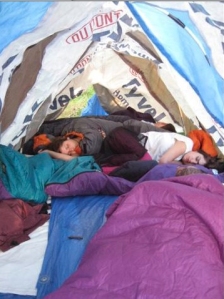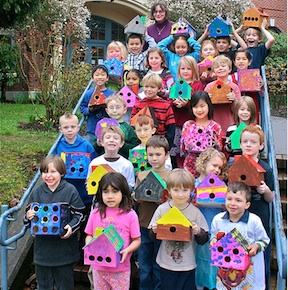The Imaginative Reinvention of Education

Pedagogical Factory: Exploring Strategies for an Educated City by the Stockyard Institute with AREA Chicago, July 22 – Sept. 23, 2007 at the Hyde Park Art Center, Chicago. Photo courtesy of Michelle Litvin
Questions: How do educators transform the cultural inheritances received from the ages of mechanical reproduction, the simulacrum, the avatar, and the metastasizing brand? How can we explore authenticity in education without wallowing in nostalgia? How can idiosyncratic vision be fostered, without celebrating a franchised cult of personality? Can data streams retain the mystery of language, of silence, of visceral necessity, so that we are not eternally mediated away from experience, made afraid of the imprecision of poetry, and dissuaded from honoring objectives in education that can’t be measured or named? What does radical mean amidst complete appropriation, and where is “outside the system” when the wild no longer exists?
These kinds of questions are huge, vital, and not often discussed outside of specialized think tanks. Public dialogue about what a good education means for this time and place is typically sidetracked, by political and economic criteria that camouflage essential value and meaning. And yet, what could be more relevant to a civilization in crisis than the process of deliberation about how minds open to new possibility?

Study at Mildred's Lane: Mildred’s Lane Fellows David Brooks and Tyler McPhee working on the Deep Craft: Bioregional Innovation Project. Using material culled from the land surrounding Mildred’s Lane, they have constructed the ‘motor’ for a human-powered lathe, consisting of a sprung pole supported by a simple trestle base, lashed together and held in tension with an elegant Spanish windlass.
Educators: There is perhaps a central, useful principle in the Latin roots of the word “e-ducation” – suggesting a leading outwards, beyond the perimeter of an inherited and molded self. There is no specific goal described anywhere in this outward movement, except maybe an implication that the student might find a way back to the starting point, having wandered with wide eyes and been changed by both the journey and the fresh perspective it offered on their origin.
What is the role of a teacher in this kind of leading out? Surely not to provide detailed maps or to head up a tour. Perhaps to walk behind, to be present at the bivouac, to tell stories of wonders seen far way, to model the alchemy of transmuting passion into discipline, to comfort when doubt becomes a chancre, and above all to believe in infinite possibility. These are all acts of love, supporting students as they embark on their own drifting journeys, while confirming that this is not essentially a solitary act.

The artists' collaborative, spurse, taught an intensive class at the Kansas City Art Institute in which students designed and tested clothing and housing systems for a nomadic journey to the arctic
Artists: What then is the relationship of the artist to this increasingly uncommon process of honest, endless seeking? If we forget (modern) historical assertions of art’s insularity, and look beyond profit-driven satisfactions of pleasure, comfort, novelty, entertainment or investment, perhaps we can say that the artists of our time are the ones who hoard darkness against the blinding light; who seed messy life in oceans of precise morbidity; who construct tiny, inquisitive instances in the path of steam-rollers.
In these moments of resilience, of self-assertion, do artists come any closer to “the truth”? Certainly, every “as if” is an illusion, and all manner of deceits can rapidly become indistinguishable from a grand, systemic lie. Poetic metaphors, though still illusions, are however made with a love of some disinterested kind. They are not tools for compliance, as many lies are, but an invitation to autonomous contemplation, nuanced interpretation and uncommon perspective. The artist’s process opens minds and creates dynamic potential. A sense of purpose and capacity arrived at from imaginative self-reflection and internal motivation is a permission slip to open the normative box and hack what is inside.
Imaginative Education: It is just this kind of implicit imaginative empowerment that most distinguishes an authentic education from conventional systems of information transfer, which instead explicitly train students to conform to prevailing standards. “Acting as if” remains a central, existential recognition of the responsibility of individuals to create meaning and growth in private and collective spheres. The role of an excellent education might then be to ensure that the assertions that any person can make in their own life, and by extension in their society, should be as imaginative, honest and responsive as they can possibly be. Will this foundation be part of our future without courageous intervention?
Let’s talk: Stepping back to see a bigger frame, the methodologies of artistic practice are essentially the same as those that equip an authentic education, establishing and supporting transient spaces from which open-ended wanderings can set out. Art making is not just a vital component of a good education, it is a living model for it. With peculiar, untamed knowledge, perceptions and language, can artists find better ways to share the power and thrill of facing fear, of investing in loss, of welcoming the unknown? Can the immense delight of creative problem-solving as a constant process be shared in public discourse about critical issues? Can artists act as provocateur-facilitators, stimulating fresh, collaborative thinking about how to teach others to see, think and create in an inventive and yet truthful way?
If we are to ever to cease stumbling through endless cycles of control and momentary release, in which the concept of power never really changes, or avoid lapsing into a deeper stasis in which revolution is just another brand, if we hope to shift fundamental human aspirations towards a more sustainable future, then perhaps artists need to be repositioned from a peripheral to a central role in social discourse. Many contemporary artists are now initiating this shift. This is a call to artist-educators who are willing to tithe their imaginations, to breathe life into public discourse and to participate in the shaping of civil society.


